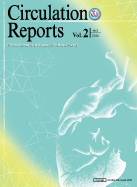Volume 2, Issue 5
Displaying 1-4 of 4 articles from this issue
- |<
- <
- 1
- >
- >|
Original Articles
Heart Failure
-
Article type: ORIGINAL ARTICLE
Subject area: Heart Failure
2020Volume 2Issue 5 Pages 265-270
Published: May 08, 2020
Released on J-STAGE: May 08, 2020
Advance online publication: March 26, 2020Download PDF (500K) Full view HTML -
Article type: ORIGINAL ARTICLE
Subject area: Heart Failure
2020Volume 2Issue 5 Pages 271-279
Published: May 08, 2020
Released on J-STAGE: May 08, 2020
Advance online publication: April 07, 2020Download PDF (1178K) Full view HTML
Ischemic Heart Disease
-
Article type: ORIGINAL ARTICLE
Subject area: Ischemic Heart Disease
2020Volume 2Issue 5 Pages 280-287
Published: May 08, 2020
Released on J-STAGE: May 08, 2020
Advance online publication: April 04, 2020Download PDF (1271K) Full view HTML
-
2020Volume 2Issue 5 Pages Content5-
Published: May 08, 2020
Released on J-STAGE: May 08, 2020
Download PDF (576K)
- |<
- <
- 1
- >
- >|
